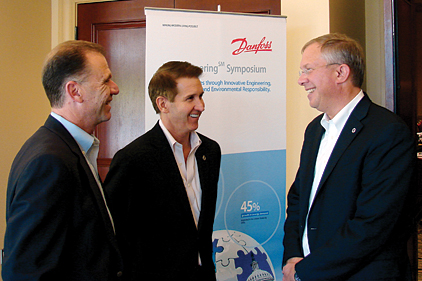
|
| From left to right: John Galyen, president of Danfoss, confers with Mark MacCracken, CEO of CALMAC, and Clay Nesler, vice president of Johnson Controls Inc., during the Danfoss EnVisioneering Symposium in Bonita Springs, Fla. |
BONITA SPRINGS, Fla. — At the recent Danfoss EnVisioneering Symposium, senior HVACR industry executives and government and industry officials explored the broad potential of the smart grid. Smart grid is a term used to describe the transformation of the existing U.S. electrical power and wiring system into a technologically advanced system that will allow for electronic communication across the entire power grid. At the symposium, speakers discussed the impact of the smart grid on the challenges faced by U.S. buildings and building systems.
Christopher Irwin, smart grid standards and operability coordinator for the Department of Energy’s (DOE) Office of Electricity Delivery and Energy Reliability, opened the symposium and underscored that HVAC manufacturers can impact the smart grid. “Equipment manufacturers know best how to optimize energy — and are most responsive to how it can be linked to the grid. Engineers need to design systems that take into consideration how they can be integrated into a whole building system and applied to a smart grid.”
Irwin called attention to DOE’s Smart Grid Investment Grant Program, totaling $7.9 billion through 2015 in grants for advanced metering, customer systems, distribution, and transmission. This pales in comparison to estimated costs for smart grid implementation. The Electric Power Research Institute estimated costs of up to $476 billion for implementation over the next 20 years, and the Edison Electric Institute estimated costs of $880 billion in a 2008 study.
David Holmberg of the National Institute of Standards and Technology (NIST) observed that as technology continues to advance — citing variable speed as an example — utilities and manufacturers need to synchronize their efforts to understand how new building technologies will integrate with and impact grid implementation.
Clay Nesler, vice president of global energy and sustainability for the Building Efficiency business of Johnson Controls, addressed the need for a whole building systems approach to create a smart building whose systems not only work together but ultimately communicate with the grid to reduce energy use during peak demand periods. According to Nesler, a significant amount of the technology necessary for a smart building is already here, but it is being underutilized.
As an example, Nesler discussed an automated demand reduction project at the Georgia Institute of Technology, which purchases electricity based on dynamic hourly pricing from the local utility, Georgia Power. Each hour, the building management system reads energy prices for the next 48 hours provided by the utility’s web service, and adjusts usage accordingly. The project resulted in an almost 1 MW reduction in peak load, which is equivalent to a 7 percent reduction in energy demand for participating buildings.
Mark MacCracken, CEO of CALMAC Manufacturing Corp., said, “As an industry, we need to encourage the designers to specify the available technology and equipment that is able to be integrated into the smart grid.” MacCracken added, “If it is not being installed now, we’re setting ourselves back by not getting the equipment into place for the future.”
He claimed few people were aware of utility rate structures and building owners needed to look at rates. “Generally you are paying at least 50 percent less at night so the key is to tap into off peak power.” He also championed energy storage as an existing technology that enables contractors and building owners to take advantage of lower energy rates.
According to Tom Catania, vice president of government relations at Whirlpool Corp., his company plans to push smart grid-ready technology into the market through a company line of smart appliances. He explained the automatic and collateral benefits, which include the ability to shift consumer energy consumption off-peak, provide quick response to spinning reserve requirements, provide information to consumers so they can make smarter choices and gain overall superior control of home appliances and energy consumption. Critical to rapid adoption of connected appliances are public policies like the Environmental Protection Agency’s (EPA) recent announcement of its intention to incorporate these products into the Energy Star program, and shifting of traditional utility consumer rebate programs to connected products that make the grid more efficient.
Whirlpool products are now designed to take peak demand into account. Refrigerators defrost at night. Dryers respond to spikes in power consumption and adjust to turn off heating elements. Catania recommended HVACR manufacturers invest in the same kinds of technology.
Citing the example of variable speed air conditioning, Robert Wilkins, vice president of public affairs at Danfoss, illustrated that technologies exist today that offer two value streams: to consumers, and to utilities. Consumers benefit from greater energy savings, increased comfort, and reduced noise compared to traditional fixed-speed systems. Utilities benefit from superior performance and responsiveness in peak utility load conditions, which can help defer investments in new power plant construction to handle the peak loads.
This was the 16th EnVisioneering Symposium since Danfoss launched the series in 2006 to keep stakeholders abreast of developments in policy and industry. The EnVisioneering series presents a forum for ongoing dialogue among industry thought leaders in research, development, and the policy community.
Publication date: 01/16/2012







